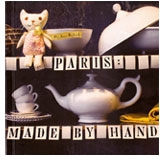Books |
Paris: Made by Hand: 50 Shops Where Decorators and Stylists Source the Chic & Unique
Pia Jane Bijkerk
By
Published: May 11, 2009
Category:
Travel
Unless you shopped at high-end boutiques and specialty stores in a handful of large American cities, it used to be that you had to go to Paris to buy French goods. Now my wife buys Anne Fontaine blouses at a discount mall — and these are the top-of-the line items, not a lesser-quality collection made just for the outlets. That’s a good thing. Still, it’s one less shop to visit if and when we haul ourselves back to France.
Not that I need a reason to go to Paris, but I have a have a new one — a book called “Paris: Made by Hand: 50 Shops Where Decorators and Stylists Source the Chic & Unique. It’s written and photographed by Pia Jane Bijkerk, an Australian stylist who works in Paris and Amsterdam. Appropriate that she should do both jobs — her book celebrates the “fait main”, the work of the hand.
You know how it is. You wander a city, skipping the establishments you know well. Soon your eye spots what you’ve overlooked. One find leads to another. Before you know it, you have a collection of shops that are one-of-a-kind and out-of-time — restored objects and furniture, fabrics not seen for decades, paper you’d never put in a Hewlett-Packard tray, vintage jewelry and more. And you have a list of workrooms that specialize in unlikely services. Umbrella repair, anyone?
The joy of these places goes far beyond the beauty of what’s on display. These small businesses are statements: History matters, artistry can’t happen on an assembly line, there’s a value to tradition. More, they’re statements about Right Livelihood, for their owners cannot possibly hope to expand their enterprises. These are artists. They may charge plenty of euros for some of their work, but they’re in it for love, not money. As you can’t miss their intent, a visit to these shops is an invitation to fall under their spell — indeed, to fall in love. [To buy “Paris: Made by Hand” from Amazon, click here.]
Ms. Bijerk is not a sadist. That is, she gives the web addresses of most of these businesses, so you can visit — and shop — virtually. Not as good as a visit, but we make do. And, if you are good at rationalization, what you don’t spend on travel, hotels and meals translates to more you can spend by shopping online.
I particularly liked:
— Alexia Hollinger, an artisan who saw no reason for handbags to be made only of leather. She scoured second-hand shops for fabric and began making seriously beautiful bags.
— Legeron, where the fabric blossoms are well worth a climb of five flights.
— Ultramod, for silk ribbon from the 1940s and rolls of silk from the 1930s.
— Marie Louise de Monterey, for vintage dresses and blouses, most often from the 1920s.
— Oh Dis Le Moi, for jewelry that can be clipped on, giving a touch of sparkle where once was only fabric.
— Mahlia Kent, creator of custom-made textiles but also, at more reasonable prices, scarves and coats made from leftover wovens.
— French Touche, for accesories, but mostly for screen-printed cushions and notebooks in colors and designs not seen for decades.
— Estelle Lemaitre, my absolute favorite, because who can resist a feather-lined lampshade?
Ms. Bijerk has organized the book sensibly, by geographical proximity. “So you don’t have to deal with the metro too often, each chapter is ‘a wander’, designed so you can walk from handmade place to handmade place with ease,” she says. Sweet. But her photographs are so appealing, her descriptions so distinct, that an hour at your desk, computer on, is almost as good. And with a wineglass at your elbow….


